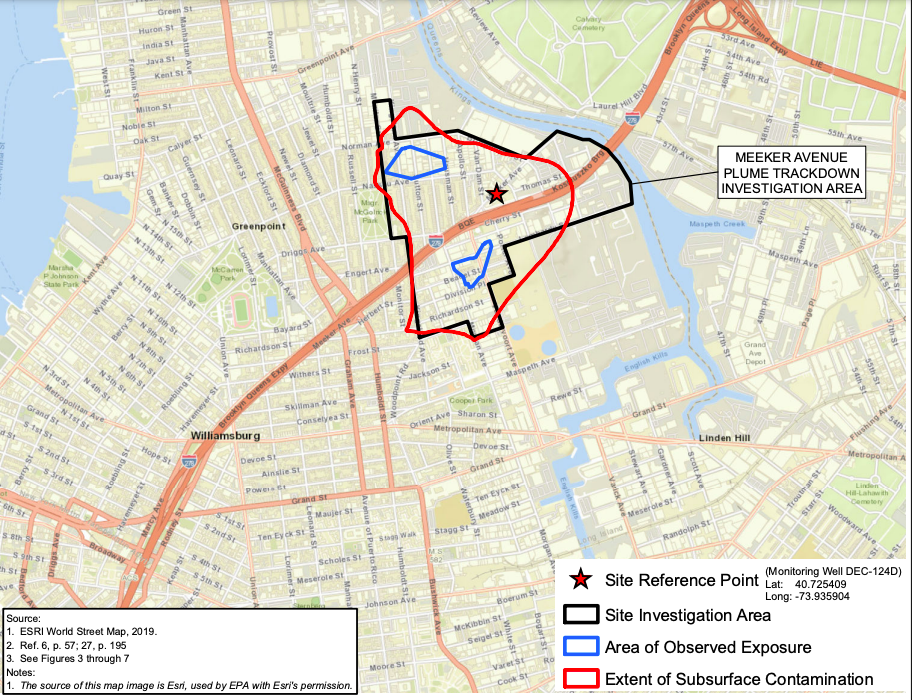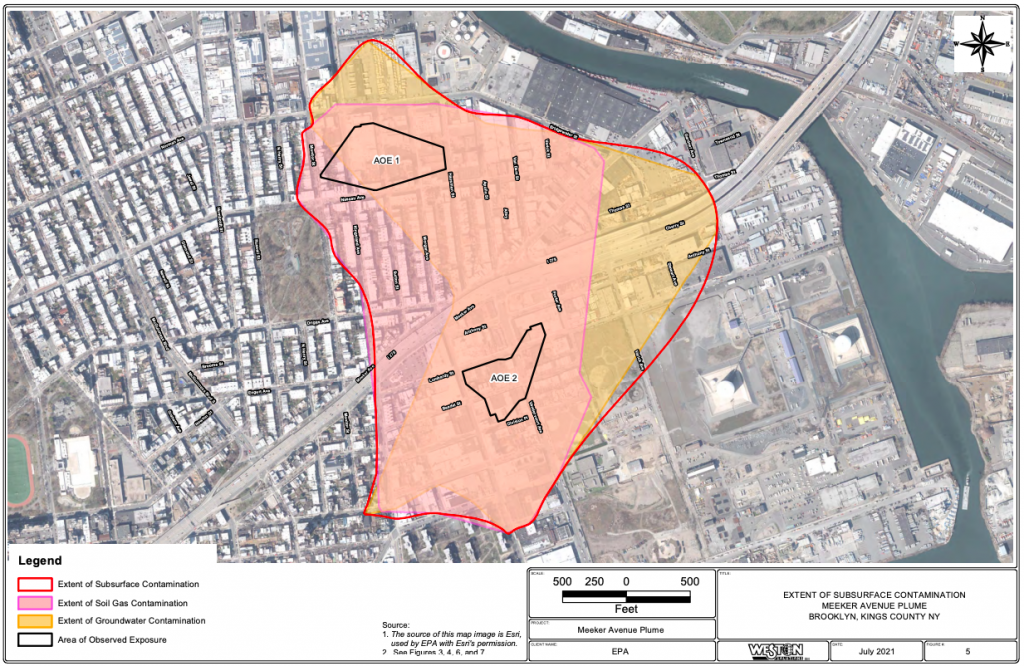Update January 2023:
The EPA has begun hosting public meetings about the Meeker Ave Plumes and is currently pursuing more extensive sampling within buildings in the Plume area. We strongly encourage residents and property owners who want to learn more about the site and sampling to contact EPA Project Managers John Brennan and Rupika Ketu – full contact info is listed on the EPA website here.
Update March 2022:
The Meeker Avenue Plumes has become a Federal Superfund site, and been added to the National Priorities List. See official EPA webpage here and stay posted to our events page and social media for upcoming events/announcements about public events.
Update October 2021:
The US EPA is considering adding the Meeker Avenue Plumes to the National Priorities List, an early step in becoming a federal Superfund Site. EPA published a notice in the Federal Register on September 9, 2021 proposing to add the site to the NPL. EPA will consider any public comments received on the listing and determine whether to finalize the site. To read the public notice and provide comments, visit https://www.epa.gov/superfund/current-npl-updates-new-proposed-npl-sites-and-new-npl-sites
NCA and North Brooklyn Neighbors (NBN) have put together talking points and instructions for submitting comments to the EPA. We encourage everyone who lives or works on/near the plumes to consider commenting. See our talking points document here. On October 25, 2021 NBN and NCA hosted a virtual informational session about the Meeker Avenue Plumes; see the full recording here.
The EPA is accepting public comments until December 8, 2021.
Read NCA’s submitted comments here.


////////////
<<< All info/text below is from 2011 and may not reflect the most recent findings regarding the Meeker Ave Plumes, please reference EPA document above>>>
Summary
The NY State Dept. of Environmental Conservation (DEC) has identified several plumes of chlorinated solvents (TCE & PCE) in the soils and groundwater beneath Greenpoint and East Williamsburg. These plumes are collectively referred to by DEC as the “Meeker Ave. Plume”. The plumes are the result of decades of dumping and irresponsible manufacturing practices by historic and contemporary drycleaning and metalworking businesses. Testing conducted by DEC has confirmed that hazardous vapors from the Meeker Ave. contaminant plumes are intruding into residential properties in the area.
Hazardous vapor intrusion from the Meeker Ave. plumes is a substantial threat to human health. Fortunately, a properly installed and maintained mitigation system can eliminate the threat of hazardous vapor intrusion, protecting residents and employees from the impacts of future exposures. Please reach out to the DOH Project Manager for information about installing mitigation systems on your property.
Background
DEC, in cooperation with DOH, began investigating the Meeker Ave. Plumes in the Spring of 2007 after results from two separate investigations conducted by the Exxon Mobil Corporation and the New York State Department of Transportation documented that soil, soil gas, and groundwater at numerous locations throughout the area had been contaminated with chlorinated solvents. The primary contaminants of concern are tetrachloroethene (PCE) and trichloroethene (TCE). These compounds have historically been used for dry cleaning and removing grease from metal respectively.
DEC and DOH are offering sub-slab/indoor air sampling free of charge to residences located in the vicinity of soil gas wells where elevated concentrations of PCE and TCE were identified. Based on the results of the sub-slab/indoor air sampling to be conducted, the DEC and DOH will determine if ventilation systems are needed at residences within the site area. These ventilation systems, known as sub-slab depressurization systems (SSDS), are designed to withdraw air from beneath the structure. This is an active system which promotes a pressure difference between the inside and outside of a structure. These systems essentially prevent the ability of soil vapors to enter structures. These systems are widely used to prevent radon gas from entering structures in areas where radon gas is naturally occurring in rock. If offered, the SSDS will be installed free of charge.
DEC will be notifying the owners of properties that have been identified as sources of contamination. These affected parties will be given the opportunity to sign a consent order with the DEC, obligating them to further investigate and remediate (cleanup) the contamination at and emanating from their site. If these parties choose not to sign an order, the DEC will undertake the investigation and remediation of the site and subsequently pursue the affected party for cost recovery.
What You Can Do to Help?
We need your help to ensure a full and thorough cleanup of contamination throughout the neighborhood. Please contact us at newtowncreek@gmail.com if you can lend your expertise or enthusiasm to our cleanup efforts. Here’s the top five things you can do today to help ensure a healthier Greenpoint / E. Williamsburg:
1) Write and call your city, state and federal elected-officials and ask them to push for a full mitigation and clean-up of the contamination.
2) Reach out to Shaun J. Surani, New York State Department of Health Project Manager for the Meeker Ave Plumes and Newtown Creek sites, to see if you can get your indoor air quality tested for free. Contact Shaun at (518) 402-7860.
3) Help educate other homeowners/tenants – pass out flyers, invite your neighbors over for coffee, etc.
4) Invite us to your group’s meeting for an informative presentation.
5) Educate yourself by reading the various documents on this website (see below).
Our Recommendations to the NYSDEC and NYSDOH
The Newtown Creek Alliance calls on DEC and DOH to take immediate action to protect human health and clean up the Meeker Ave. Plumes. DEC/DOH:
• Should work with the Newtown Creek Alliance to establish a cooperative vapor intrusion testing outreach effort for those residences potentially impacted by the Meeker Ave. Plumes.
• Should provide an accounting of their community outreach efforts so that the effectiveness of their communications strategies may be evaluated accurately and improved upon if necessary.
• Should provide a timeline for all aspects of their investigation, mitigation, and remediation efforts.
• Should mitigate the residences impacted by the Meeker Ave. Plumes and mitigation should proceed according to the most rapid schedule possible. Because the cost of mitigating homes and businesses with vapor intrusion problems is comparable to the cost of testing and because seasonal and daily variations make it difficult to accurately measure the true concentration of chlorinated solvents under foundations and in indoor air, mitigation systems should be offered to all the homes and businesses within the footprint of the plumes.
• Should remediate the Meeker Ave. plumes and remediation should proceed according to the most rapid schedule possible.
• Should work to revise the New York State air guideline for PCE of 100 ug/m3*. DOH’s PCE-in-indoor-air guideline is 250 times higher than U.S. EPA’s Regional Screening Level of .41 ug/m3.
• Should work to revise the New York State air guideline for TCE of 5.0 ug/m3. DOH’s TCE-in-indoor-air guideline is two orders of magnitude higher than the most protective risk-based concentrations for TCE in air developed by California, Colorado, New Jersey and several EPA regional offices, which range from 0.016 to 0.02.
*ug/m3 = micrograms per cubic meter
News Coverage
Brownstoner. 11/9/21. Deadline Extended for Comments on Designating Meeker Avenue Plume a Superfund Site
Gothamist. 11/1/21. “This Brooklyn Chemical Spill Is Constantly Spewing Fumes. The EPA Wants It To Be A Superfund Site”
Daily News. 2/18/10. “Probers unearth toxin shock in Greenpoint groundwater”
YourNabe.com. 2/17/10. “Activists ‘PERC’ up to new findings”
Gothamist. 2/16/10. “Greenpoint: Even More Polluted Than You Thought!”
The Brooklyn Paper . 2/16/10. “Pollution under Greenpoint? It’s worse”
New York Post . 2/10/10. “DEC expands Meeker plume testing”
Daily News. 2/19/09. “Rep. Velázquez Urges Brooklyn Residents To Cooperate With Health Investigation”
Daily News. 2/9/09. “Greenpoint to get greener, Superfund money to pay for nabe’s toxic cleanup”
Brooklyn Paper. 1/29/09. “Superfund to pay for Greenoint Cleanup”
Daily News. 12/9/08. “State Testing 450 Greenpoint Homes Sitting on Plume of Toxic Chemicals “.
New York Times. 12/7/08. “A Problem Rises to the Surface in Greenpoint”.
Greenpoint Star. 12/4/08. “Blooming Plumes Spells Greenpoint Doom”.
Educate Yourself – Learn More
DEC/DOH Meeker Ave. Plume Fact Sheet
DEC Meeker Ave. Plume Residential Air Sampling Report 2008 (summary, 4.2mb)
DEC Meeker Ave. Plume Residential Air Sampling Report 2008-2009 (summary, 1mb)
DEC Meeker Ave. Plume Trackdown Phase 1 report (introduction only, 196kb)
DEC Meeker Ave. Plume Trackdown Phase 2 report (introduction only, 580kb)
DEC Meeker Ave. Plume Trackdown Phase 3 report (introduction only, 692kb)
DEC Meeker Ave. Plume Trackdown Phase 4 report (introduction only, 643kb)
DEC Meeker Ave. Plume Trackdown Phase 5 report (introduction only, 575kb)
Meeker Ave. Plume Map (4mb, note that the layers can be toggled on and off)
Former Spic & Span Cleaners Remedial Investigation Fact Sheet – English (104kb)
Former Spic & Span Cleaners Remedial Investigation Fact Sheet – Polish (578kb)
Former Klink Kosmo Cleaners Remedial Investigation Fact Sheet – English (106kb)
Former Klink Kosmo Cleaners Remedial Investigation Fact Sheet – Polish (552kb)
PCE Standards Letter to NYSDOH
Results from the initial 2006/2007 ExxonMobil Greenpoint oil spill vapor intrusion and indoor air sampling investigation
Slide from the October 16th, 2007 DEC/DOH presentation in Greenpoint detailing two “areas of concern” where elevated levels of several chemicals were found during the 2006/2007 ExxonMobil Greenpoint oil spill vapor intrusion and indoor air sampling investigation
Center for Pubic Environmental Oversight “A Stakeholder’s Guide to Vapor Intrusion”
DOH “Guidance for Evaluating Residential Soil Vapor Intrusion in the State of New York” and fact sheets on PCE and TCE
DEC “Vapor Intrusion Guidance” and “Strategy For Evaluating Soil Vapor Intrusion at Remedial Sites in New York”
NY State Assembly Report, “Vapor Intrusion of Toxic Chemicals: An Emerging Public Health Concern”
EPA Guide, “Building Radon Out: A Step-by-Step Guide on How to Build Radon-Resistant Homes”. Radon sub-slab depressurization systems are identical to those used to mitigate vapor intrusion from chlorinated solvents or other VOCs.